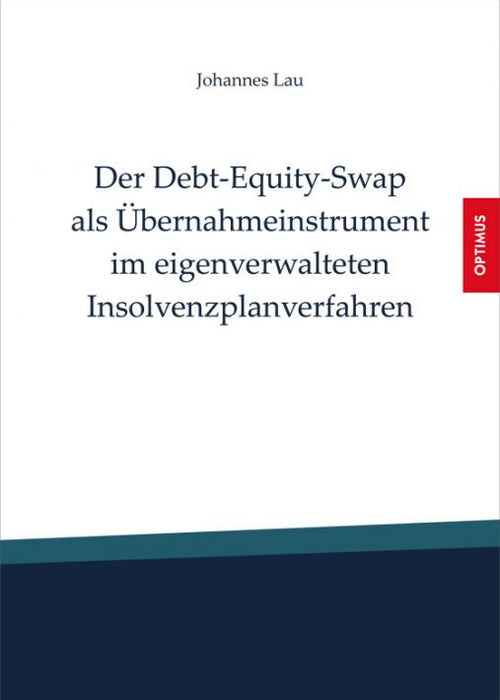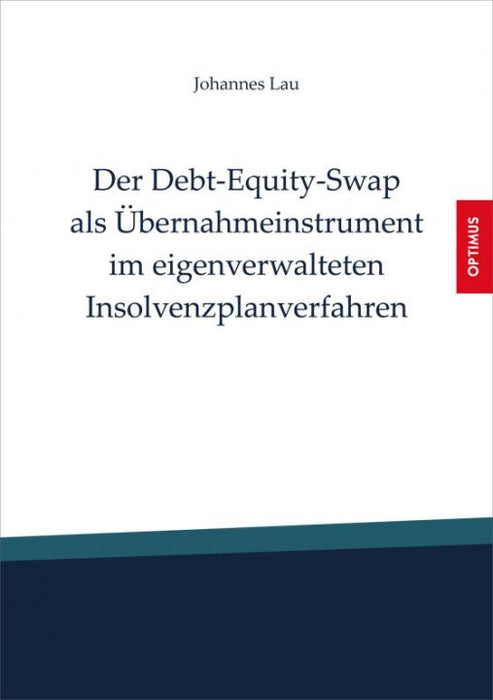The debt-equity swap as a takeover instrument in self-administered insolvency plan proceedings
- Brand: Lau, Dr. Johannes
- Availability: In stock
- SKU: 9783863761912
€59,90
With the law to further facilitate the restructuring of companies (ESUG), the legislature had set out to subject the German insolvency law, which is systemically geared towards breaking up and liquidation, to a new restructuring culture. The present study contributes to the legal discussion about the problems raised in this...
With the law to further facilitate the restructuring of companies (ESUG), the legislature had set out to subject the German insolvency law, which is systemically geared towards breaking up and liquidation, to a new restructuring culture. The present study contributes to the legal discussion about the problems raised in this context and in particular investigates the question of whether the insolvency law reform has created easier conditions for the takeover of companies in addition to a legally secure and planning-safe framework for successful company restructuring. Following the presentation and evaluation of selected procedures, reform studies and practical opinions, the author examines how the debt-equity swap can be converted into a concept for (restructuring) company takeovers, especially in self-administered insolvency plan proceedings. Even if the (preliminary) self-administration procedures are by no means a necessary prerequisite for a debt-equity swap – after all, an insolvency administrator can also work towards this – they offer significant implementation simplifications with a view to use as a takeover instrument. Finally, the conditions for a largely plannable insolvency are shown, with special consideration of the Chief Restructuring Officer's ability to influence the self-administered insolvency plan procedure and the parties involved.
Details
- Title: The debt-equity swap as a takeover instrument in self-administered insolvency plan proceedings
- Author: Dr. Johannes Lau
- Series: Series of publications on corporate, tax and insolvency law
- Edition: 1st edition
- Band: 3
- Publisher: Dr. Jan Niklas Bittermann, Dr. Johannes Lau, Dr. Sebastian Brinkmann
- Published: 1st edition 10.11.2016
- Subject: Law
- Product Type: Book (Hardcover)
- Product type: Dissertation
- Language: German
- Binding: Softcover (paperback)
- Dimensions: 21.0 x 14.8 cm (DIN A5)
- Scope: 173 pages
- Condition: New (shrink-wrapped in foil)
- Keywords: debt-equity swap, distressed debt investing, self-administration, ESUG, valuation of receivables, shareholder position in insolvency, law to facilitate the restructuring of companies, insolvency plan proceedings, insolvency squeeze-out, insolvency law reform, capital cut, restructuring instrument, protective shield proceedings , corporate restructuring, corporate takeover, takeover instrument
Table of Contents
§ 1 Introduction
I. Introduction
II. course of work
§ 2 Basics of Debt-Equity Swaps
I. Introduction and Definition
1. How it works
2. Historical Development
3. Variants/Manifestations
II. Economic Background
1. Concept of crisis
2. Options for action
a) Terminology of company restructuring
b) Liquidation of the company ("breakup")
c) Continuation of the company (sponsor)
III. Delimitation of the debt-equity swap to the transferring restructuring
1. Benefits of Transferred Remediation
2. Disadvantages of transferring redevelopment
IV. Implementation under corporate law
1. Capital reduction
2. Capital increase against contributions in kind
3. Cash capital increase to legal minimum
4. Exclusion of subscription rights
5. Reorganization blockade potential of the old shareholders
v Relationship to the insolvency proceedings
IV interim result
1. Free/extrajudicial reorganization
2. Restructuring in insolvency proceedings
a) Situation before the insolvency law reform
b) Reform of insolvency law and reform goals
VI. Intermediate result
§ 3 The debt-equity swap in insolvency
I. Standard insolvency proceedings
II. The reformed insolvency plan procedure
1.Legal nature of the insolvency plan
2 Object of the insolvency plan
3. Procedure
III. Practical utilization of self-administration
1. Provisional self-administration (§ 270a InsO)
2. Procedure to prepare for a reorganization (§ 270b InsO)
3. Position of the creditors' committee
4. Position of Custodian
5. Advisor participation and restructuring director
IV. Practical Utilization of the Debt-Equity Swap
1. Inclusion of the equity rights in the insolvency plan
2. Extension of the ban on obstruction
3. Limited legal protections
4. Additional implementation simplifications
v Intermediate result
§ 4 First experiences under the new law
I. ESUG studies/voices on the success of the reform
II. First practical use cases
1. Pfleiderer AG
2. Suhrkamp Verlag GmbH & Co. KG
3. SIAG Schaaf Industrie AG
4. centrotherm photovoltaics AG
5. IVG Immobilien AG
6. Prokon Regenerative Energies GmbH
III. Lessons learned from the first procedures
§ 5 Shareholder position and valuation issues in the planning process
I. Introduction to the problems
II. Compatibility with superior law
1. Constitutional requirements
2. European legal requirements
3. Shareholder Compensation
a) Share valuation based on liquidation values
b) Consideration of continued values
c) Stock market value as a basis for calculation
d) Statement
4. Intermediate result
III. Prerequisites and scope of the exclusion of subscription rights
1. Company law justification of a subscription right
a) § 225a Para. 3 InsO as a legal reference
b) At least the right to participate in a cash capital increase
2. Insolvency law overlays corporate law
3. Opinion
4. Intermediate result
IV. Valuation of receivables as part of the contribution in kind
1. Actual Economic Value
a) Continuation values as a basis for calculation
b) Liquidation values as a basis for calculation
2. Debt-Equity Swap at Par
a) Balance sheet approach
b) Practical arguments for a nominal value contribution
3. Opinion
4. Intermediate result
§ 6 The debt-equity swap as a takeover instrument
I. Foundations of the remedial takeover
1. Introduction
2. Motives/interests of those involved
3. Takeover term
4. Distressed Debt Investing
5. Influencing through the acquisition of receivables
a) Types of receivables and security levels
b) Financial covenants
c) Cooperation with creditors
6. Intermediate result
II. Strategic use of the reformed self-administration
1. Placement of own advisors
a) Chief Restructuring Officer as self-administrator
b) Influencing management
2. Creditors' committee right of co-determination
a) Control of committee size
b) Opinion
3. Selection and control of the administrator
4. Position of the bankruptcy court
5. Intermediate result
III. Strategic insolvency plan creation
1. Plan Template Permission
2. Group Division Right
a) Strategic group strength
b) Use of fictional approval
c) Increase in approval rate through purchase
d) Abuse limit and judicial control
3. Intermediate result
IV. Intervention in a self-reorganization initiated by the debtor
1. Changed motives of those involved on the debtor side
2. Influencing before submitting an application
a) Indirect influence on the insolvency application
b) Easier access to self-administration via § 270b InsO
3.Influencing after own application and opening of the procedure
a) Influencing the appointed creditors' committee
b) Submission of competing insolvency plans
c) Influencing a debtor's plan
4 defensive strategies
5. Intermediate result
v Criticism of the status quo
1. Abuse of the protective shield procedure
2. Advisor Influence Reach
3. Criticism of the example of Chapter 11
4. Demand for non-insolvency reorganization proceedings
5. Reform of restructuring tax law
6. Opinion
§ 7 Conclusion
Bibliography
Downloads
.DRM: Digital Watermark
This eBook contains a digital watermark and is therefore personalized for you. If the eBook is passed on to third parties abusively, it is possible to trace it back to the source.
File format: PDF (Portable Document Format)
With a fixed page layout, the PDF is particularly suitable for specialist books with columns, tables and figures. A PDF can be displayed on almost all devices, but is only suitable to a limited extent for small displays (smartphone, e-reader).
System requirements:
PC/Mac: You can read this eBook with a PC or Mac. You need a PDF viewer - e.g. Adobe Reader.
eReader: This eBook can be read with (almost) all eBook readers. However, it is not compatible with the Amazon Kindle.
Smartphone/Tablet: Whether Apple or Android, you can read this eBook. You need a PDF viewer - e.g. Adobe Reader.
Buying eBooks from abroad
For tax law reasons we can sell eBooks just within Germany and Switzerland. Regrettably we cannot fulfill eBook orders from other countries.



